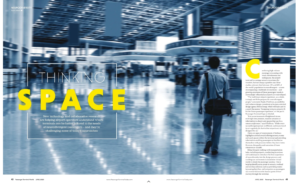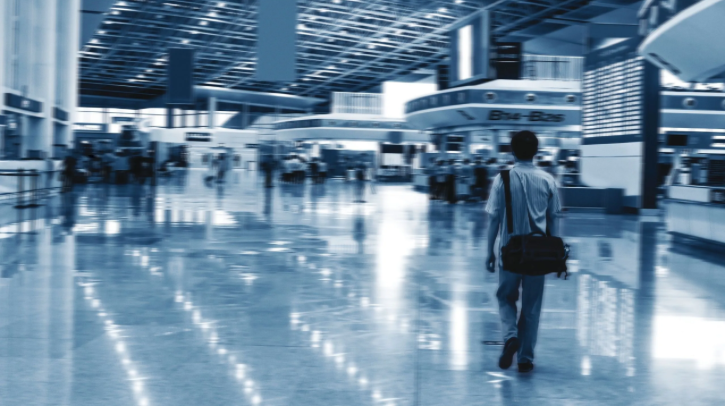New technology and collaborative research are helping airport operators understand where terminals can be better tailored to the needs of neurodivergent passengers – and they’re challenging some of today’s approaches.
Combining high-volume passenger processing with retail, refreshments and workspaces, the airport terminal is a unique sensory experience for travelers, but not always a positive one. Most studies estimate that between 15% and 20% of the world’s population is neurodivergent – a term encompassing a multitude of conditions – and growing awareness of those passengers’ needs is increasingly influential as airports are redeveloped.
“The traditional airport experience, as a whole, is simply not fit for purpose for neurodivergent people,” comments Nuala O’Sullivan, accessibility and inclusive design consultant at human-centered design agency Mima Group, which will take part in a panel discussion, ‘Designing inclusive airports fit for the future passenger experience’, at this year’s Passenger Terminal Expo in Madrid.
“It is an environment of heightened stress, with high time pressure, massive amounts of information to absorb and spaces that can be a sensory nightmare,” says O’Sullivan. “While every neurodivergent person is different, and many travel by air regularly, the fact is that airports are not designed for us.”
There are signs of improvement. O’Sullivan highlights a trend toward offering sensory rooms and quiet spaces within the terminal and providing information enabling passengers to familiarize themselves with processes before they leave home. However, the quality and execution of those initiatives is variable.
Mima Group is working with transportation hubs, including airports, conducting interviews and workshops to introduce the lived experience of neurodiversity into the design process, and tracking eye movements in immersive virtual reality to study the passenger journey. This is helping identify areas prone to sensory overload and develop solutions such as providing routes bypassing duty free, and rest points so passengers can recover between the busiest parts of their journey through the terminal.
 “One of the primary challenges is a joined-up approach between airports.”
“One of the primary challenges is a joined-up approach between airports.”
Nuala O’Sullivan, Mima Group
O’Sullivan continues, “‘Nothing about us, without us’ is the foundation of what we do. I am a neurodivergent person, embedded in the design team, and I am speaking to a group of people with different but related lived experience, all working together to better the design. That creates a unique empathy and can break down the hierarchy of designer/user that is an impediment to real co-design.”
Room for improvement
This collaborative approach is echoed by Airports Council International (ACI), which is working with advocacy groups and other partners to develop best practice. The association launched an accreditation program in 2022 to encourage continuous improvements in accessibility, supported by guidance for terminal design. Neuro-inclusive initiatives suggested to operators include providing maps to help passengers avoid over-stimulating areas; measures to control noise, intense lighting and strong smells; and offering safe spaces within the terminal.
However, as Matt Needham, director of aviation and transportation at architecture firm HOK, explains, implementing those changes can be challenging. Dedicated rooms are competing with the need for functional infrastructure and high-rent retail and food units within terminal layouts that are often decades old, which can limit their effectiveness.
“The general approach of having a dedicated space someplace in the airport is fundamentally flawed. You must have this destination in mind, and 90% of the time go out of your way to get to it. If you have to spend time and effort to get to a destination to feel better, most likely you won’t do it. Often sensory rooms are used as break rooms for employees, sometimes they double as religious rooms where people can find solace to pray. By and large, they are not being used as intended – to ease people’s anxiety,” he says.

“We think that more appropriate neurodiverse design application is not in a single space that you have to seek out, but a variety of experiences, curated intentionally, so that you have a choice.”
Needham highlights HOK’s recent redevelopment of LaGuardia Terminal B as an example. The ticket hall is naturally lit and deliberately large, which reduces the sense of it being such a busy environment. Passengers then pass through an elevated security area and heavily glazed bridges with views of the New York skyline and planes moving underneath, before descending to the gates. The route offers calming pocket parks and an open-plan space near the gates, so passengers can rest within sight of where they need to get to.
“One of the defining natures of airports in the last 30 or 40 years, is – especially post-security – they’re very insulated, secure by definition, almost hermetically sealed. Wouldn’t it be nice if you were in that concourse area and you have access to real trees, real sunshine and maybe a breeze?” Needham asks.
“That is a relatively inexpensive way to provide some relief. If it’s located in much more populated areas along the concourse to break things up, or in the center of a connection hub you have to walk through, [then] people have that choice. That’s what we find is part of a neurodiverse approach to a passenger experience.”
Model example
New technology is helping validate those improvements. Architectus launched its Airport User Experience Simulation System (A-UX) at 2022’s Passenger Terminal Expo in Paris, after a four-year development program led by principal and aviation sector leader Karl Traeger.
The system was inspired by seeing his adopted son, who has achondroplasia dwarfism, interact with VR games. Developed with the support of psychologists, mental health professionals and Autism Spectrum Australia (ASA), it enables passengers to explore the terminal virtually and supports better training by giving staff a new perspective on those environments.
“It’s been amazing finding airport staff coming out of it saying they had no idea what people were dealing with,” says Traeger. “We’re on a path to try and measure improvements in throughput and staff well-being, as well as using immersive simulations to help people familiarize themselves with the journey. Bringing those things together, we can improve throughput and reduce disruption – which the airport is interested in.”
Several of Australia’s east-coast airports and Schiphol in Amsterdam have already modeled terminals for A-UX, and the system also provides opportunities to learn. Operators can use the system to test initiatives, such as orientation points, seating areas or quiet moments, and how they are coordinated within the journey through a terminal, and adjust them if necessary.

“We can help simulate airports in very detailed models to string those touchpoints together. That’s not about a one-moment solution, it’s that string of pearls – from orientation points that can point you in the direction of a specific lane, or an opportunity to peel out of a queue to manage anxiety in a sensory or quiet ‘pod’. That’s what we’re working on, that string of different moments for passenger support,” Traeger continues.
“We’re in an age of customization, and we can really nuance for people’s experience rather than working to the broad passenger profiles that we’ve had for years. We are getting far better at nuancing the touchpoints and helping focus where airports are spending their money, because we’re also getting better at measuring the outcomes that drive the next design decisions. The next step is demonstrating how these interventions can work, what actually works, what touchpoints airports are prepared to invest in, overlaying security requirements and demonstrating to governments we have the data that proves that these initiatives will benefit people.”
Board approval
For Royal Schiphol Group, A-UX builds on an existing range of initiatives focused on neuro-inclusive processes, according to Laurens van Oostendorp, product owner within the IT and security department. The airport’s passengers with reduced mobility sounding board group now includes a representative with non-congenital brain damage and another from the Stichting voor Autisme foundation, and it conducts regular surveys to identify where improvements are needed.
“We’re in an age of customization, and we can really nuance for people’s experience.”
Karl Traeger, Architectus
“People appreciate the personal assistance we offer at the airport; both the service and the employees are highly valued. This service can be booked with the airline prior to the journey, and Schiphol will arrange this at the airport as required. This way, people can receive personal, customized assistance at Schiphol from an employee,” van Oostendorp explains.
“We are also getting feedback that there is still room for improvement, both in terms of facilities at the airport and facilities that people can consult digitally at home. People want to travel and preferably as independently as possible. We are learning about this, and we are going to do various pilots to adjust our services specifically with regard to the neurodivergent group.”
“People want to travel, and preferably as independently as possible.”
Laurens van Oostendorp, Royal Schiphol Group
A-UX is offering virtual models for passengers to explore Schiphol in advance and is also informing and testing changes. This has helped optimize designs for security assets, improved staff training and is supporting a pilot of ‘small houses’ – enclosed, heavily sound-insulated spaces for two or three passengers throughout the terminal.
“These low-stimulus spaces will be located at various points – identified by means of digital VR simulation for effectiveness – along the passenger route so that people have a moment for themselves at various points along their route through Schiphol, [and] will be manned during the pilot phase,” adds van Oostendorp.
“We are curious to see how much they are used, how long people stay there, and what their experience is. After the pilot phase, we will evaluate. The intention is to eventually implement an optimal version of this at the airport.”

Museum makeover
O’Sullivan believes aviation could learn from other sectors, highlighting Mima’s work with museums. This sector, she says, understands the visitor experience in minute detail, anticipating how people move through galleries and their direction of gaze, while recognizing how those moments shape memories of that space. Museums are also making progress in staff training and awareness of disabilities and neurodiversity, which are initiatives she’d like to see more of in airports.
“We see our airport clients focusing more and more on the idea of an airport as a destination,” she comments. “The terminal is not just a functional space, but can be a park, a play area, a shopping experience, an exhibition space. This means there is an enormous amount of learning about sensory experience and design that can be drawn from other sectors. At Mima, we bring a lot of learning from our work with museums to aviation projects.”
HOK’s Needham also sees opportunities to share best practice, notably from stadiums, which have similar challenges – such as security, ticketing, concessions and large crowds – to contend with. Providing spaces that alleviate anxiety for neurodivergent travelers could have wider benefits, offering a more appealing experience for all passengers and a competitive advantage for operators.
“Respecting and enhancing people’s lives is what you go into architecture for. I think we have a little bit better dialog now, because of neurodiversity, to have people maybe experience and understand it a little bit better. There are amazing airports out there that function well, that are growing, that have opportunities to incorporate some of these ideas in them,” he says.

“I think we’re on the verge of a traveler revolution. Remember when it was so romantic to fly? The whole customer service, martinis on the tray, black and white nostalgia of the romance of travel? If we do this right we can really be on the verge of a new romance of travel. And people will love to travel.”
Setting standards
Regulations could have an important role in driving inclusive design into airports. Mima’s Nuala O’Sullivan highlights the European Accessibility Act, which requires specific measures to ensure products and services meet the needs of people with disabilities and has helped raise awareness. The BSI (UK national standards body) PAS 6463 ‘Design for the Mind’ standard also offers guidelines for new buildings to cater for neurodivergent visitors, though it isn’t specific to airports.
However, she adds, there is often a gap between best practice and meeting the legal minimum. Mima recently supported Heathrow Airport by developing an inclusive design standard, bespoke to that environment and pushing beyond legislative requirements. This includes measures supporting disabled staff members, guidance for awareness training and engaging with passengers, and will underpin future developments in phases.
“I would like to see more airports adopt this approach, co-developing good practice standards with people with lived experience,” she says. “One of the primary challenges is a joined-up approach between airports. If you have the most inclusive experience of your life at the start of your journey, it can be ruined by a barrier at your destination airport. Regulation could be one route to push for better communication here.”
This article originally appeared in the April 2025 issue of PT World. This issue was packed full of fantastic content, including features on the digitalization of retail, expert cybersecurity and strategic masterplanning, as well as exclusive interviews with top executives on some of the world’s most ambitious airport development projects, such as King Salman International Airport Development Company and Melbourne Airport. To view the magazine in full, click here.

